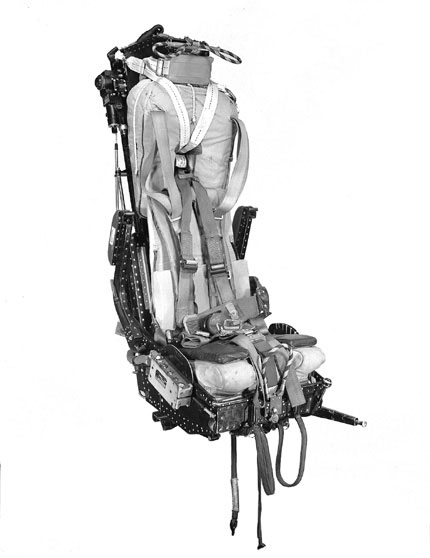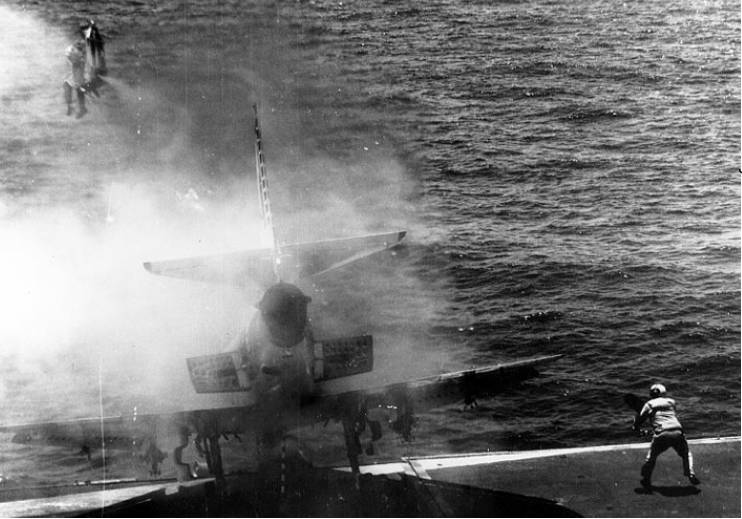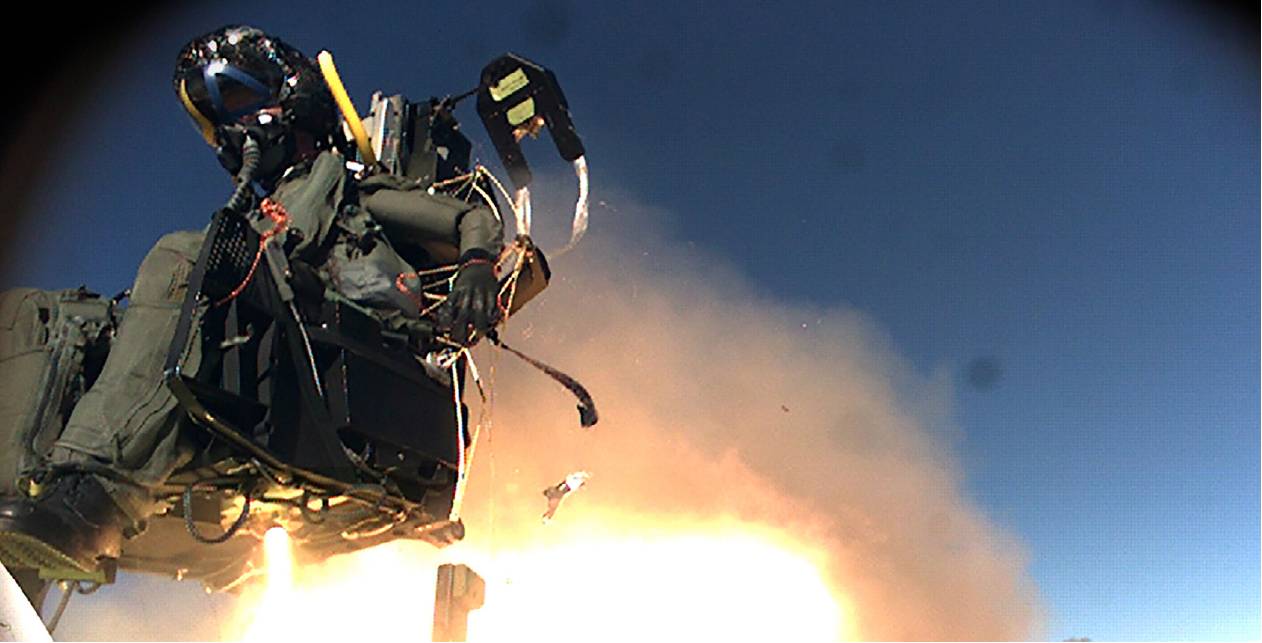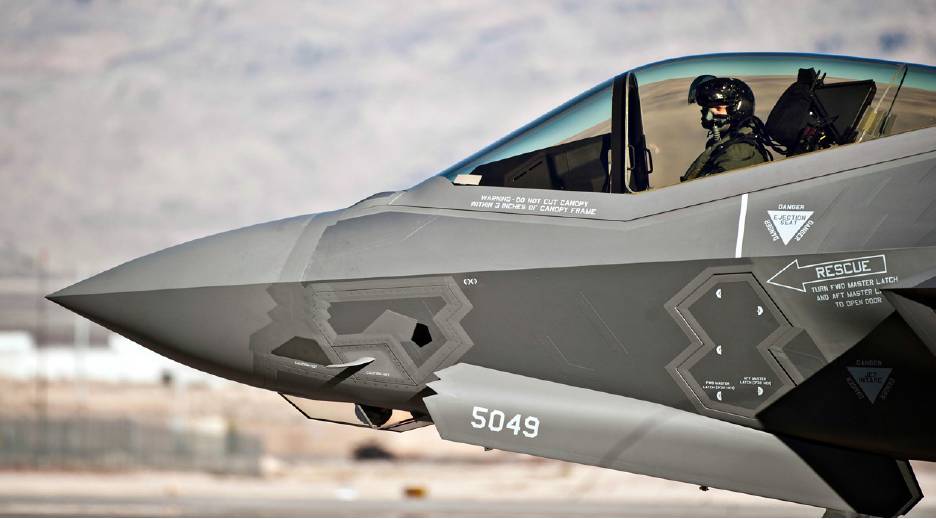9 April 1958: Highest emergency ejection (Flt Lt John Peter F de Salis and F/O Patrick H G Lowe, Double Scorpion Canberra BMk6, 56,000ft, Monyash, Derbyshire, Semi-Automatic Mk1C).
1 October 1959: First supersonic emergency ejection (Test Pilot John W C Squier, English Electric Lightning T4 XL628, 35,000ft over Solway Firth off Garlieston).
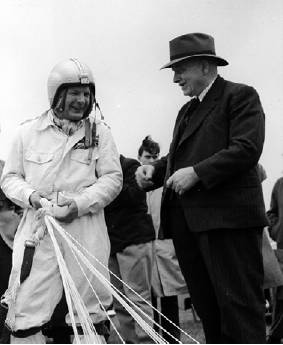 Sir James Martin and William ‘Doddy’ Hay, 1961 who carried out the first live zero-zero ejection. Martin-Baker
Sir James Martin and William ‘Doddy’ Hay, 1961 who carried out the first live zero-zero ejection. Martin-Baker
1 April 1961: World’s first live zero/zero (zero speed/ altitude) static rocket seat ejection. (William T H ‘Doddy’ Hay, 300ft from ground, Chalgrove) (left).
13 March 1962: World’s first rocket-assisted ejection from an aircraft in flight (Sqn Ldr Peter Howard in the Martin-Baker Mk4 seat from a modified Meteor 7 at 250ft, Chalgrove).
By 1965 Martin-Baker advertised that 1,000 lives had been saved by its products and, subsequently, 2,000 (April 1968), 3,000 (July 1971), 4,000 (April 1976), 5,000 (February 1983), 6,000 (December 1990), 7,000 (June 2003) and 7,500 (2016). The 22 November 1969 recorded the highest number of Martin-Baker ejections in a single day, 11 – during the Vietnam War. In the United States early key ejections included:
17 August 1946: Sgt Lawrence Lambert ejects from modified Northrop XP-61B at 6,000ft over Patterson Field, Dayton, OH to test Air Materiel Command’s ejection seat.
1 November 1946: Lt Adolph ‘Chubby’ Furtek USN undertakes second ‘live’ test ejection using MartinBaker seat (Douglas A-26, Lakehurst, NJ).
 World’s first live zero/zero (zero speed/ altitude) static Martin-Baker rocket seat ejection in 1961. Martin-Baker
World’s first live zero/zero (zero speed/ altitude) static Martin-Baker rocket seat ejection in 1961. Martin-Baker
9 August 1949: First emergency ejection in the United States (Lt Jack L Fruin, F2H-Banshee, Walterboro, SC).
26 February 1955: First emergency supersonic ejection (Test pilot George Franklin Smith, F-100 Super Sabre, Mach 1.05, South Bay Coast, Los Angeles).
28 August 1957: First live runway ‘test’ ejection of Martin-Baker Mk4 seat in US (F/O Sydney Hughes RAF, Grumman F9F-8T Cougar, US Naval Air Test Center, Patuxent River, MD).
The US Navy (USN) began to show interest in the Martin-Baker ejection seat as early as 1946. However, understandably, there was some opposition in the US to purchasing British ejection seats for installation in American aircraft and it was not until 1957 following the Hughes ejection (which satisfied the naval requirement to use only ‘zero-zero’ ejection seats in all future, and existing, aircraft projects, following the loss of 172 USN pilots that year at low altitude/ low airspeed) that the Martin-Baker Mk5 was ultimately selected as the standard seat in USN combat aircraft which resulted in numerous aircraft modifications.
 The USAF trailed behind, relying on aircraft manufacturers (including Convair, Lockheed, Douglas, Republic, North American and Northrop) to design seats resulting in a plethora of concepts (including downward ejection) overseen by the Industry Crew Escape Systems Committee, Stanley Aviation and Aircraft Mechanics Inc being the other major suppliers. Initially based on a US Army Corps-captured Heinkel He-162 seat design, Aircraft Mechanics Inc became a major supplier of ejections seats for the USAF (B-57A, B-66, F-84F, F-105, F-100D, F-106).
The USAF trailed behind, relying on aircraft manufacturers (including Convair, Lockheed, Douglas, Republic, North American and Northrop) to design seats resulting in a plethora of concepts (including downward ejection) overseen by the Industry Crew Escape Systems Committee, Stanley Aviation and Aircraft Mechanics Inc being the other major suppliers. Initially based on a US Army Corps-captured Heinkel He-162 seat design, Aircraft Mechanics Inc became a major supplier of ejections seats for the USAF (B-57A, B-66, F-84F, F-105, F-100D, F-106).
Founded by Robert M ‘Bob’ Stanley (1912–1977), who as a Bell test pilot had made the first US jet flight (XP-59A 1 October 1942, Muroc Dry Lake, CA), from 1949 Stanley Aviation Corporation focused on aircraft escape and survival systems, including a downward-firing ejection seat (B-47, B-52, RB-66, FJ-3, F-102, F-104), Yankee Escape System (A-1E Skyraider) and special escape capsules (B-58 Hustler).
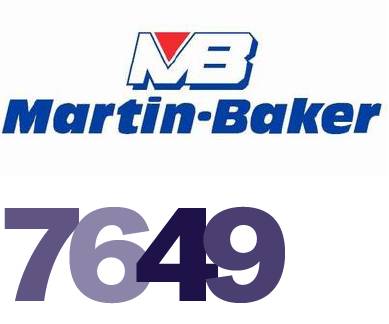 Lives saved as claimed by Martin-Baker to presentConcerning research aircraft, although the Bell X-1 and X-2 were not fitted with ejection seats, the Douglas X-3 had a downward-firing ejector seat. The North American X-15 had a winged seat for ejection up to Mach 4 at 120,000ft. Although the development of ejection seats has involved the use of rocket sleds (including research trials undertaken into human tolerance by Stanley Aviation at Hurricane Mesa UT and Col John Paul Stapp at Edwards AFB and Holloman AFB), anthropomorphic dummies and human volunteers, occasionally animals have been used.
Lives saved as claimed by Martin-Baker to presentConcerning research aircraft, although the Bell X-1 and X-2 were not fitted with ejection seats, the Douglas X-3 had a downward-firing ejector seat. The North American X-15 had a winged seat for ejection up to Mach 4 at 120,000ft. Although the development of ejection seats has involved the use of rocket sleds (including research trials undertaken into human tolerance by Stanley Aviation at Hurricane Mesa UT and Col John Paul Stapp at Edwards AFB and Holloman AFB), anthropomorphic dummies and human volunteers, occasionally animals have been used.
 A British pilot exits his crash-landing Harrier jump jet at Kandahar, Afghanistan, in May 2009. The pilot ejected to safety via his rocket-fired ejector seat, once he had steered his Harrier past a civilian passenger aircraft also on the runway. Martin-Baker
A British pilot exits his crash-landing Harrier jump jet at Kandahar, Afghanistan, in May 2009. The pilot ejected to safety via his rocket-fired ejector seat, once he had steered his Harrier past a civilian passenger aircraft also on the runway. Martin-Baker Everard Richard Calthrop’s prophetic visualisation of an aircraft ejection seat which was to be operated by a ‘hand-lever’ – included in his 22 September 1916 patent application Improvements relating to Parachutes (GB111,498A), a development of his ‘Guardian Angel’ parachutes which Calthrop (1857–1927) championed against British military intransigence over pilot safety during WW1 – became a reality in Britain 30 years later when on 24 July 1946 (75 years ago) a mechanic volunteer Bernard Ignatius Lynch (1918–1986) ejected at 8,000ft from the rear cockpit of a Gloster Meteor Mk3 travelling at 320mph using a Martin-Baker ejection seat. Lynch, who was to undertake 30 more airborne test ejections, was the first person outside of Germany to eject from an aircraft in flight.
Everard Richard Calthrop’s prophetic visualisation of an aircraft ejection seat which was to be operated by a ‘hand-lever’ – included in his 22 September 1916 patent application Improvements relating to Parachutes (GB111,498A), a development of his ‘Guardian Angel’ parachutes which Calthrop (1857–1927) championed against British military intransigence over pilot safety during WW1 – became a reality in Britain 30 years later when on 24 July 1946 (75 years ago) a mechanic volunteer Bernard Ignatius Lynch (1918–1986) ejected at 8,000ft from the rear cockpit of a Gloster Meteor Mk3 travelling at 320mph using a Martin-Baker ejection seat. Lynch, who was to undertake 30 more airborne test ejections, was the first person outside of Germany to eject from an aircraft in flight. 


